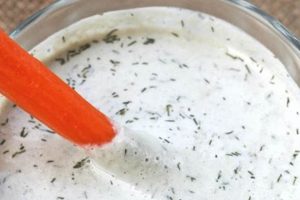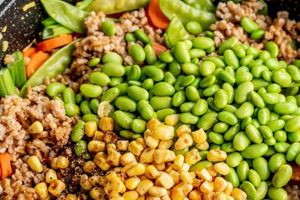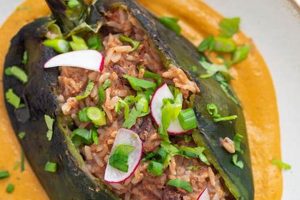These culinary creations present a departure from the traditional sweet breakfast staple. They offer a nutritious and versatile meal option suitable for those adhering to plant-based diets. The core element consists of oats prepared with non-dairy liquids and incorporating flavors typically found in lunch or dinner dishes. Examples include oatmeal with sauted vegetables, seasoned with herbs and spices, or topped with avocado and a drizzle of plant-based hot sauce.
The significance of such recipes lies in their ability to provide a balanced and satisfying meal. They can be an excellent source of fiber, protein (especially when supplemented with ingredients like beans or lentils), and essential nutrients. Their historical context, while not deeply rooted in traditional oatmeal preparations, represents a modern adaptation driven by dietary preferences and a desire for convenient, wholesome food options. The accessibility and affordability of oats further contribute to the appeal and growing popularity of this style of cooking.
The following discussion will explore various ingredient pairings, preparation techniques, and nutritional considerations for creating fulfilling and delicious plant-based, non-sweet oat-based meals. Detailed methods, ingredient suggestions, and considerations for dietary restrictions will be provided.
Tips for Preparing Non-Sweet, Plant-Based Oat Dishes
Effective creation of satisfying and nutritionally balanced non-sweet, plant-based oat dishes requires careful consideration of ingredient selection, flavor profiles, and preparation methods. These tips aim to provide guidance for achieving optimal results.
Tip 1: Embrace Umami-Rich Ingredients: Incorporate ingredients such as nutritional yeast, miso paste, tamari, or dried mushrooms to introduce savory depth and complexity to the flavor profile. For example, adding a teaspoon of miso paste to the cooking liquid enhances the overall savoriness.
Tip 2: Prioritize Texture: Oatmeal’s inherently soft texture can benefit from the addition of contrasting elements. Introduce ingredients like toasted nuts, seeds, or crispy vegetables to provide textural interest. Sauting finely diced vegetables until slightly caramelized offers both flavor and textural enhancement.
Tip 3: Utilize Aromatic Spices and Herbs: Bold spices and fresh herbs are crucial for developing a well-rounded flavor. Consider combinations such as turmeric, cumin, and coriander for an Indian-inspired dish, or garlic, oregano, and basil for a Mediterranean influence.
Tip 4: Incorporate Plant-Based Protein Sources: Enhance the nutritional value and satiety of the meal by adding plant-based protein sources such as lentils, beans, tofu, or tempeh. Pre-cooked lentils or crumbled tofu can be easily incorporated during the final stages of cooking.
Tip 5: Opt for Vegetable Broth or Seasoned Water: Enhance the flavor foundation by cooking oats in vegetable broth instead of plain water. Alternatively, season the water with a pinch of salt and a bay leaf for added depth.
Tip 6: Consider Creamy Additions: A touch of plant-based milk or a dollop of avocado can add richness and creaminess to the finished dish. Stirring in a tablespoon of coconut milk at the end of cooking can significantly improve the texture.
Tip 7: Balance Flavors: Pay attention to the balance of salty, acidic, and umami notes to create a harmonious flavor profile. A squeeze of lemon juice or a dash of vinegar can brighten the overall taste.
Successful implementation of these tips will result in a diverse range of palatable and nutritious plant-based, non-sweet oat-based meals that offer a significant departure from traditional sweet oatmeal preparations.
These foundational principles are essential for creating diverse and appealing plant-based, non-sweet oat dishes.
1. Umami Flavor Development
The development of umami, the savory fifth taste, is a critical component in the successful formulation of plant-based, non-sweet oat dishes. Traditional oatmeal relies on sweetness for palatability; conversely, these adaptations necessitate the careful cultivation of savory flavors to achieve a satisfying gustatory experience. The absence of umami often results in a bland or incomplete flavor profile, rendering the dish unappetizing. The incorporation of umami-rich ingredients acts as a foundation, building a savory complexity that complements the inherent nuttiness of oats. For example, the addition of roasted mushrooms, a naturally occurring source of glutamate, infuses the dish with depth. Similarly, a small amount of miso paste introduces a concentrated umami element, transforming the flavor from one-dimensional to layered and nuanced.
The selection of ingredients and preparation methods directly influences the intensity of umami. Slow roasting vegetables, such as tomatoes or onions, enhances their inherent glutamate content. Employing techniques like caramelization further concentrates flavors and contributes to the overall umami sensation. Furthermore, strategic layering of umami sources, such as combining nutritional yeast with sun-dried tomatoes, creates a synergistic effect, amplifying the savory impact. The practical application involves understanding the glutamate content of various ingredients and consciously incorporating them into the dish to achieve the desired flavor intensity.
In conclusion, umami flavor development is not merely an optional addition but an essential element for the creation of palatable and satisfying plant-based, non-sweet oat dishes. The strategic use of umami-rich ingredients, coupled with appropriate preparation techniques, is paramount for transforming a potentially bland dish into a flavorful and complex culinary experience. Overcoming the challenge of creating satisfying savory flavors in a traditionally sweet context necessitates a deliberate and informed approach to umami development.
2. Textural Contrast Importance
Textural contrast holds significant importance in the creation of appealing plant-based, non-sweet oat dishes. The inherently soft and homogenous nature of cooked oats necessitates the inclusion of diverse textures to elevate the sensory experience and prevent a monotonous mouthfeel.
- Raw vs. Cooked Components
The juxtaposition of raw and cooked elements introduces dynamic variation. Incorporating raw vegetables, such as finely diced bell peppers or shredded carrots, offers a crisp counterpoint to the softened oats. Conversely, lightly sauted or roasted vegetables provide a different textural dimension, adding a degree of tenderness while retaining some structural integrity. The application of these contrasting textures significantly enhances the overall complexity of the dish.
- Crunchy Toppings
The addition of crunchy toppings is a straightforward method to improve textural contrast. Toasted nuts, seeds, or crispy fried onions introduce a distinct element that contrasts with the creamy oats. The selection of toppings influences the flavor profile as well; for instance, toasted sesame seeds impart a nutty flavor, while crushed tortilla chips provide a salty and crunchy element. The application should be strategic to ensure the toppings remain distinct from the base.
- Creamy and Chunky Elements
Combining creamy and chunky elements creates a layered textural experience. A swirl of avocado puree or a dollop of plant-based yogurt provides a smooth, velvety texture that contrasts with the solid elements in the dish. The addition of chopped vegetables, beans, or lentils introduces distinct chunks, further enhancing the textural complexity. This combination contributes to a more satisfying and complete sensory experience.
- Preparation Techniques
Preparation techniques play a crucial role in manipulating the texture of individual ingredients. Lightly roasting vegetables before incorporating them into the dish can concentrate their flavors and create a slightly caramelized exterior, contrasting with the soft oats. Similarly, toasting nuts and seeds intensifies their crunch and enhances their aroma. The skillful application of these techniques is essential for achieving the desired textural balance.
The strategic integration of diverse textures transforms plant-based, non-sweet oat dishes from a potentially bland and monotonous meal into a complex and satisfying culinary creation. The combination of raw and cooked elements, crunchy toppings, and creamy and chunky components is essential for elevating the overall sensory experience and enhancing the appeal of these dishes.
3. Nutritional Completeness
Nutritional completeness is a critical factor in the design and evaluation of plant-based, non-sweet oat dishes. The inherent nutritional profile of oats, while offering benefits such as fiber and certain micronutrients, is incomplete as a standalone meal. A lack of careful planning can result in a dish deficient in essential amino acids, vitamins, and minerals. Therefore, the integration of diverse ingredients is paramount to transforming a simple oat preparation into a nutritionally robust and balanced meal. This is particularly important for individuals adhering to plant-based diets, where nutrient deficiencies can be more prevalent if dietary choices are not consciously considered. Examples of potential deficiencies include vitamin B12, iron, and omega-3 fatty acids.
Achieving nutritional completeness in plant-based, non-sweet oat dishes involves strategic ingredient selection. Incorporation of legumes, such as lentils or chickpeas, provides a significant source of protein and essential amino acids, complementing the protein found in oats. Dark leafy greens, such as spinach or kale, contribute vitamins, minerals, and antioxidants. Adding seeds, such as flax or chia, introduces omega-3 fatty acids and fiber. Furthermore, fortification with vitamin B12 through nutritional yeast or supplements can address a common deficiency in vegan diets. Practical application involves understanding the nutritional content of various plant-based foods and combining them in a way that addresses potential gaps in the diet. This might involve combining oats with sauted tofu, broccoli, and a drizzle of tahini, creating a dish that provides a balance of protein, carbohydrates, healthy fats, vitamins, and minerals.
In summary, nutritional completeness is not an optional consideration but an essential element in the successful creation of plant-based, non-sweet oat dishes. Failure to prioritize nutrient density can result in a meal that, while potentially palatable, lacks the necessary components for optimal health and well-being. The challenge lies in balancing flavor, texture, and nutritional value to create dishes that are both satisfying and contribute to a balanced dietary intake. Addressing this challenge requires a conscious effort to incorporate a diverse range of nutrient-rich ingredients into the oat base.
4. Ingredient Synergy
Ingredient synergy represents a critical facet in the development of palatable and nutritionally balanced non-sweet, plant-based oat dishes. The interaction between various ingredients, rather than their individual contributions, significantly shapes the final flavor profile and nutritional value. A deliberate approach to ingredient selection and combination is therefore essential.
- Flavor Amplification through Complementary Pairings
Certain ingredients, when combined, exhibit a synergistic effect, resulting in a flavor intensity greater than the sum of their individual contributions. For example, the combination of mushrooms and soy sauce (or tamari) enhances the umami flavor, due to the complementary amino acids present in both components. Applying this principle, incorporating roasted mushrooms and a touch of tamari into a plant-based oat dish significantly elevates its savory complexity.
- Textural Harmony via Contrasting Elements
Ingredient synergy extends beyond flavor to encompass textural considerations. The juxtaposition of soft oats with crunchy elements, such as toasted nuts or seeds, creates a more engaging sensory experience. Furthermore, the incorporation of creamy components, such as avocado or plant-based yogurt, can enhance the overall mouthfeel. These textural contrasts contribute to a more complete and satisfying dish.
- Nutrient Bioavailability Enhancement
Certain ingredient combinations can enhance the bioavailability of specific nutrients. For example, pairing iron-rich foods, such as spinach or lentils, with vitamin C-rich ingredients, such as bell peppers or lemon juice, improves iron absorption. Integrating these pairings into non-sweet, plant-based oat dishes can optimize their nutritional benefits.
- Flavor Balancing through Opposing Sensations
Successful ingredient synergy often involves balancing opposing flavor sensations. A touch of acidity, from lemon juice or vinegar, can brighten the savory profile and counteract any perceived blandness. Similarly, a subtle sweetness, derived from caramelized onions or roasted sweet potatoes, can add depth and complexity without compromising the savory character of the dish.
The application of ingredient synergy principles is paramount in transforming simple oats into compelling and nourishing non-sweet, plant-based meals. Careful consideration of flavor amplification, textural harmony, nutrient bioavailability, and flavor balancing contributes to the creation of dishes that are both palatable and nutritionally complete. These synergistic effects are integral to maximizing the potential of plant-based ingredients and achieving a truly satisfying culinary outcome in non-sweet, plant-based oat-based recipes.
5. Preparation Techniques
Preparation techniques exert a direct influence on the palatability and overall success of plant-based savory oatmeal recipes. The inherent texture of oats, often described as bland and somewhat mushy, necessitates skillful manipulation through various culinary methods to achieve a desirable outcome. Incorrect or inadequate preparation can result in a dish that is unappetizing, regardless of the quality of ingredients used. For example, undercooked oats retain an unpleasant grittiness, while overcooked oats become excessively gluey, both detracting from the dining experience. Precise timing and liquid ratios are thus critical factors in the initial cooking phase.
Beyond the foundational cooking of the oats themselves, the preparation techniques applied to accompanying ingredients are equally important. Sauting vegetables to caramelize their natural sugars, roasting them to concentrate their flavors, or pickling them to add a contrasting acidity all contribute significantly to the overall flavor profile of the dish. Consider a recipe incorporating mushrooms: simply adding raw mushrooms to cooked oats will result in a bland and uninteresting dish. However, sauting the mushrooms with garlic and herbs before combining them with the oats transforms the dish into a savory and complex creation. Similarly, the manner in which plant-based protein sources are prepared, whether it’s pan-frying tofu to achieve a crispy exterior or simmering lentils with spices for added depth, directly impacts the final result. These steps showcase an understanding of the different preparation methods and how they interplay with each other in the recipe.
In conclusion, preparation techniques are not merely a set of instructions to be followed, but rather an integral component of plant-based savory oatmeal recipes. Mastering these techniques allows for the transformation of a simple grain into a complex and satisfying meal. Understanding the impact of different methods on both the oats themselves and the accompanying ingredients is essential for achieving the desired flavor, texture, and overall appeal. Proper cooking techniques, combined with intentional ingredient choices, lead to the creation of dishes that demonstrate the versatility and potential of savory oatmeal in plant-based cuisine.
6. Flavor Balancing
Flavor balancing constitutes a fundamental principle in the successful execution of non-sweet, plant-based oat preparations. The inherent neutrality of oats necessitates a strategic manipulation of taste elements to achieve a palatable and satisfying dish. In the absence of appropriate flavor balance, these recipes may present as bland or lacking in complexity, thus diminishing their appeal. This balancing act typically involves the careful interplay of saltiness, acidity, sweetness (often minimal and derived from vegetables), bitterness, and umami. The deliberate calibration of these elements is crucial for creating a well-rounded and enjoyable gustatory experience. A savory oat recipe incorporating mushrooms, for instance, might require a touch of acidity from lemon juice to cut through the earthy richness and prevent the dish from becoming overly heavy. Similarly, a hint of sweetness from caramelized onions can complement the savory notes and add depth.
Practical application of flavor balancing principles involves a continual process of tasting and adjustment during the cooking process. The initial flavor foundation is typically established through the use of ingredients like vegetable broth or seasoned water, which provide a base level of saltiness and umami. Subsequent additions, such as herbs, spices, and vegetables, contribute further complexity to the flavor profile. The final adjustments often involve the addition of acidic elements, such as vinegar or citrus juice, to brighten the dish and create a sense of equilibrium. The choice of plant-based protein sources also impacts flavor balance; ingredients like tofu or tempeh may require additional seasoning to complement the overall flavor profile. A miso-glazed tofu, for example, introduces a distinct umami and salty element, necessitating careful consideration of other ingredients to ensure a harmonious balance. The lack of focus is a critical miss of the recipe.
In conclusion, flavor balancing is an indispensable component of successful non-sweet, plant-based oat dishes. Achieving this balance requires a nuanced understanding of how different taste elements interact and the deliberate application of techniques to create a cohesive and satisfying culinary experience. This often presents a challenge, given the inherently neutral base of the oats, but the rewards of a well-balanced dish are significant, elevating the recipe from a simple preparation to a complex and flavorful meal. A balanced profile of savory oat meal allows people to have a better option of Vegan recipe.
Frequently Asked Questions
This section addresses common inquiries regarding the preparation, nutritional aspects, and variations within the realm of plant-based, non-sweet oat dishes.
Question 1: Can traditional rolled oats be used in savory recipes, or are steel-cut oats preferred?
While steel-cut oats offer a chewier texture, both rolled oats and steel-cut oats can be successfully utilized. Rolled oats cook more quickly, making them a convenient option for weekday meals. Steel-cut oats require a longer cooking time but provide a more robust and textured result.
Question 2: Is it necessary to use vegetable broth as the cooking liquid, or can water be substituted?
Vegetable broth enhances the savory flavor profile, but water can be substituted. If using water, it is recommended to season it generously with salt, herbs, and spices to compensate for the lack of inherent flavor.
Question 3: What are some effective plant-based protein sources to incorporate into these dishes?
Excellent options include lentils, chickpeas, tofu, tempeh, edamame, and plant-based protein powders. These ingredients contribute essential amino acids and increase the satiety of the meal.
Question 4: How can one ensure adequate vitamin B12 intake when relying on plant-based, savory oatmeal?
Vitamin B12 is not naturally found in plant-based foods. Supplementation with nutritional yeast fortified with B12 or a B12 supplement is recommended to prevent deficiency.
Question 5: What strategies can be employed to enhance the texture of savory oatmeal, preventing it from being overly mushy?
Incorporating toasted nuts, seeds, crispy vegetables, or a fried egg (if not strictly vegan) introduces textural contrast. Adjusting the cooking liquid ratio and avoiding overcooking are also crucial.
Question 6: Can these recipes be prepared in advance for meal prepping purposes?
Savory oatmeal can be prepared in advance, but the texture may change upon refrigeration. It is recommended to slightly undercook the oats initially and add a splash of liquid when reheating to restore the desired consistency.
In conclusion, these FAQs provide insight into key considerations for preparing satisfying and nutritionally sound plant-based, non-sweet oat dishes. Paying attention to these details will contribute to a more positive culinary experience.
The following discussion transitions to actionable recipes and specific ingredient combinations.
Conclusion
The preceding exploration elucidates the fundamental principles and techniques required for the successful creation of palatable and nutritious “savory oatmeal recipes vegan.” Key aspects such as umami flavor development, textural contrast importance, nutritional completeness, ingredient synergy, preparation techniques, and flavor balancing have been thoroughly examined. Emphasis was placed on the strategic selection and combination of plant-based ingredients to overcome the inherent limitations of a traditionally sweet dish, thereby transforming oats into a versatile and satisfying savory meal option.
Given the increasing demand for plant-based dietary options and the inherent nutritional benefits of oats, further experimentation and refinement of “savory oatmeal recipes vegan” are warranted. The potential for innovation within this culinary domain remains vast, offering opportunities to expand the repertoire of accessible, affordable, and nutritionally complete plant-based meals. Continued dedication to thoughtful recipe development will contribute to the mainstream adoption of this versatile and healthful dish.







